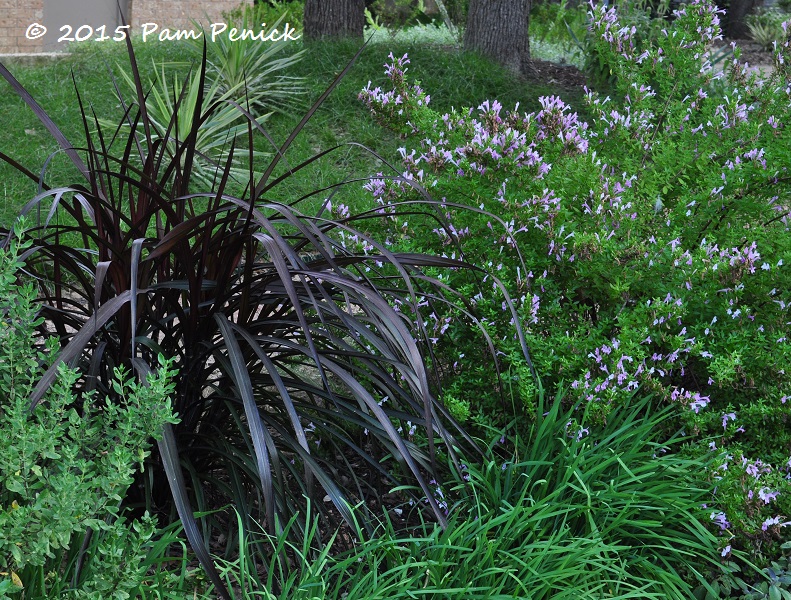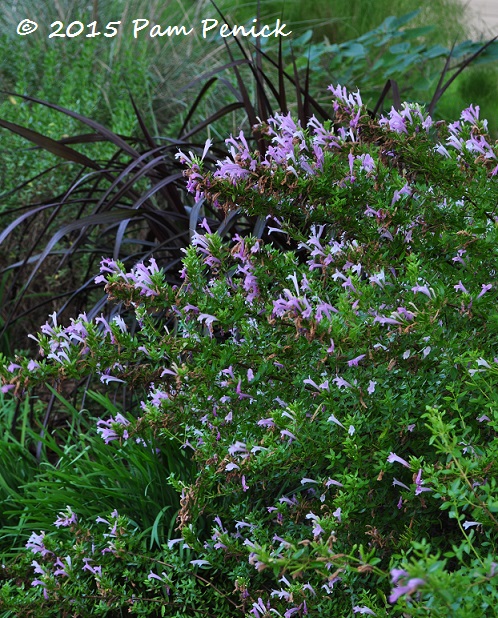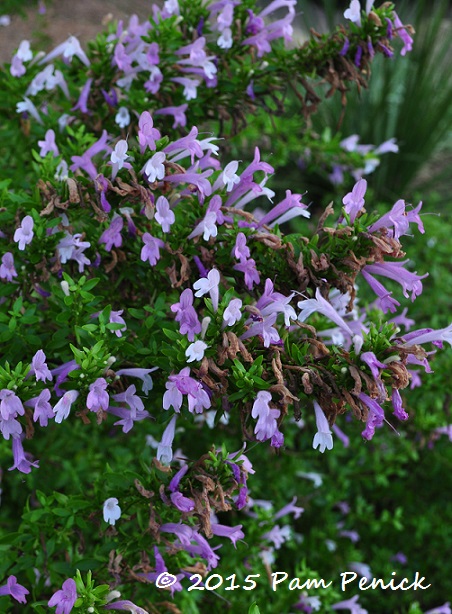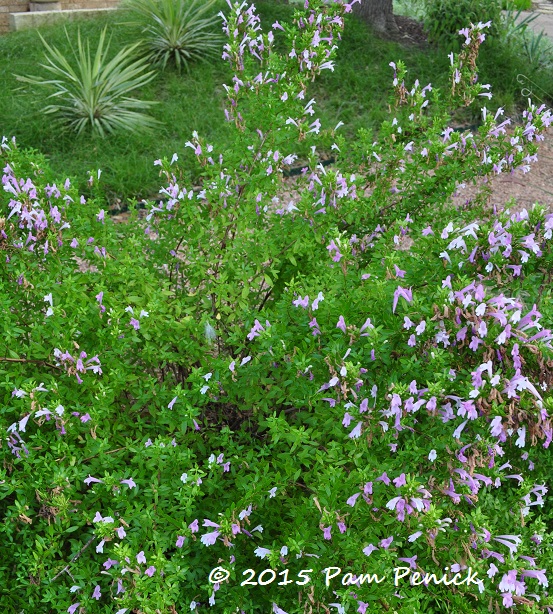Mexican oregano and a tall, dark, handsome partner
Each year I replant a purple fountain grass (Pennisetum setaceum) next to the Mexican oregano (Poliomintha longiflora) in the streetside garden. I love the rich color echo between the Mexican oregano’s lilac flowers and the grass’s dark leaves, which look good late-spring through fall and even, bleached by frost, into winter.
This year I’m trialing a new variety (for me) of dark-leaved ornamental grass: Pennisetum purpureum ‘Vertigo’ from Proven Winners, also known as Pearl Millet. So far it seems like purple fountain grass on steroids, with deeper purple coloring, a wider leaf, and a plumped up form. This baby is expected to get big, maybe even 6 feet tall.
Proven Winners sent three of these grasses to me in quart-size containers in April, and they’ve responded to all our spring rain with quick growth. They’re shots of dark drama in my mostly silvery green, silvery blue, and dusty green garden — in other words, a good accent plant. The only downside I know of, compared to purple fountain grass, is that ‘Vertigo’ won’t bloom, so no dusty pink bottlebrush flowers this fall. The upside is that its sterility keeps it from being an aggressive spreader in warm climates like mine.
The Mexican oregano is providing plenty of flower power right now. Its scented branches are absolutely laden with tubular flowers that attract hummingbirds and sphinx moths.
Mexican oregano also looks pretty fab with the key-lime-pie-colored ‘Margaritaville’ yucca, but that’s another story.
All material © 2006-2015 by Pam Penick for Digging. Unauthorized reproduction prohibited.






Wow, what spectacular color! I wouldn’t care that it didn’t flower with color like that. Too bad they’re not hardier.
Proven Winners lists ‘Vertigo’ as a zone 8 plant hardy to 15F. We’ll see. I find purple fountain grass will sometimes come back from our winters, but it’s never as vigorous. I don’t mind replacing one or two every year. It’s a bargain for the long season of interest you get from these grasses. —Pam
The grass it pretty and a great accent, but I’m in love with your Mexican Oregano–a plant that I’ve had no luck with. I’ll enjoy yours.
The deer squashed a couple of mine this year. But this one is doing well at least! —Pam
I have Vertigo! It’s great. Came back from the roots this year with no problems, and I like the wider leaf, which reminds me off all the phormiums I can’t grow here. I also like “Princess Caroline” and “Princess Mollie” (which is NOT a dwarf version of P. Caroline, unless the one I got was mislabeled). They’re absolutely showstopping once they’re established, as you’ll see at Lois’s garden on the Inside Austin Gardens Tour in October!
No kidding, it’s a true perennial? No sign of aggressive spreading, I hope. It’s a lovely grass, and yes, it’s a good substitute for those phormiums we can only lust after. —Pam
Oh, and I have also heard that since it doesn’t flower, it doesn’t also fall apart and lose its form in the winter the way regular purple fountain grass tends to do. It’s too early for me to say with my 3 Pennisetum purpureum varieties, but my hopes are high!
Good to know. Thanks, Lori. —Pam
Part of me has to admit jealousy in your wide range of plants you can grow. Another part of me is thankful that we don’t have to deal, I think, as aggressively with the possibility of invasive plants as you might. But still, I look at this combo and swoon. Time for more containers!
It’s a rare treat to see a sphinx moth here but we do see them, especially on dianthus. I’m always surprised to hear when someone didn’t know that tomato hornworms become glorious sphinx moths. It’s worth planting a row of tomatoes you’re not totally excited about and relocating the hornworms there as you find them.
Good tip, Anna. However, they must feed on other plants as well because I have no tomatoes and see plenty of sphinx moths in my garden. They’re a delight to watch. —Pam
I absolutely get weak in the knees over that dark purple in the landscape. I suppose that is why I keep moving bits of tradescantia pallida around. It may not be native but it is a close enough neighbor it is happy with local pollinators. If this grass proves perennial and non-invasive, native or not,with a display like that? room could be made, room could be made…
I’ll keep you updated, Deb, and perhaps Lori will too. —Pam
Oooooooo you know I loooove that purple!
Me too, Heather! —Pam
I have vertigo from your Vertigo! A dark grass somehow makes everything around it look more substantial. I love how the purples compliment each other!
Vertigo is pretty stunning. I’m glad I gave it a try. —Pam
I’m a sucker for dark purple foliage. I planted purple fountain grass last year since I couldn’t pass up the great foliage and fluffy blooms, but, I’m not big on planting annuals every year, unless I can do so from seed or really cheap flats, so no more fountain grass for me for the foreseeable future. Do you have to treat the Vertigo as an annual here as well, or is it a perennial. If perennial, I’ll have to add it to my garden wish list.
Proven Winners listed it as an annual, Rebecca, but Lori, who commented above, says it’s a perennial in her Austin garden. I’ll know by next summer. —Pam